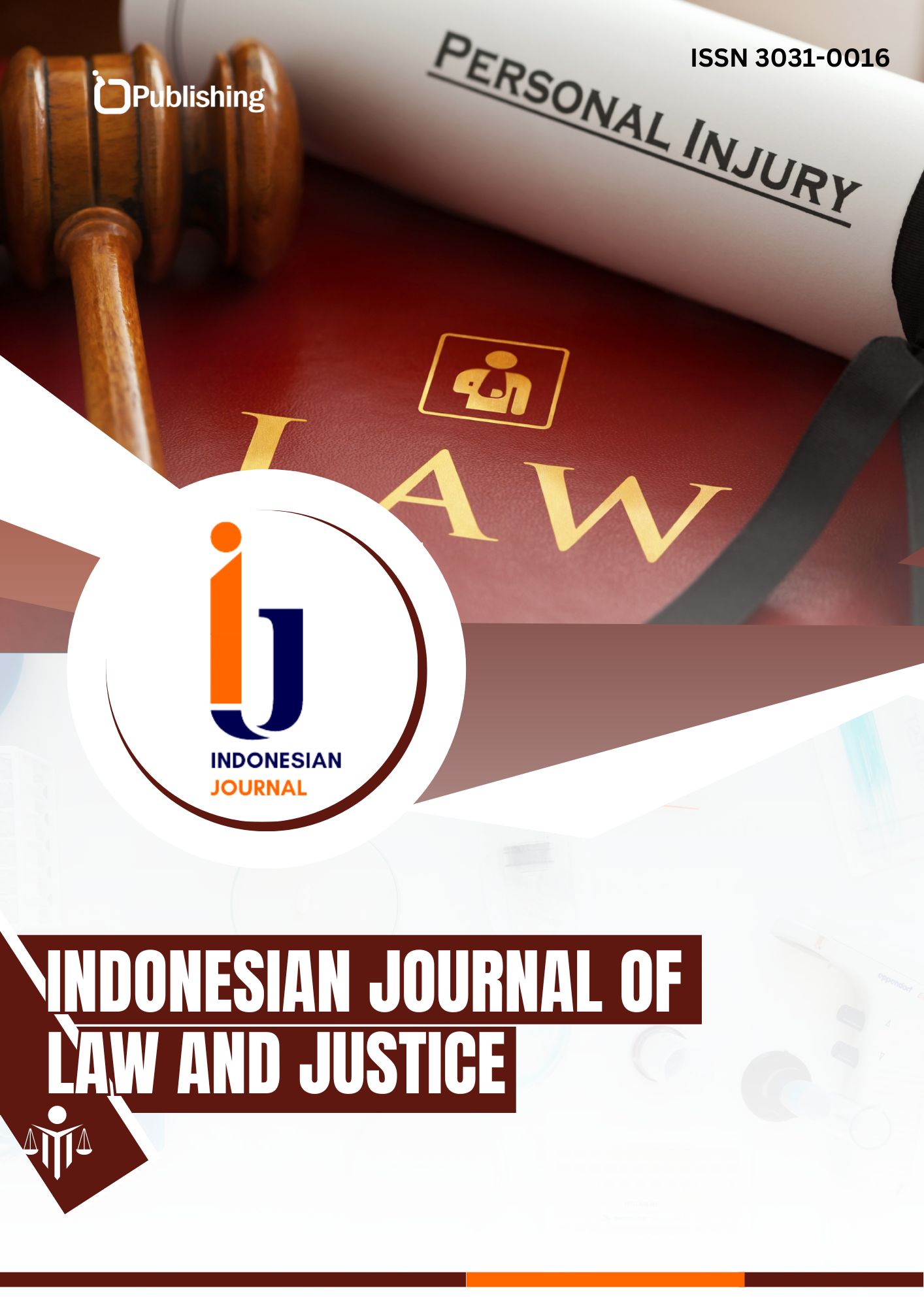Legal Analysis of the Handling of M-Bangking Electronic Evidence in Bribery Cases in the Digital Era
DOI:
https://doi.org/10.47134/ijlj.v2i3.3625Keywords:
Electronic Evidence, Criminal Law, M-Banking, Bribery, ITE LawAbstract
Evidence in cybercrime cases can be easily erased or eliminated, and there are challenges in detecting crimes that occur in the banking sector that utilizes computer technology. This difficulty arises due to the lack of adequate equipment, the lack of courage of some victims to report the incident to the authorities, as well as the relatively weak security system of the owner of the asset or system. In addition, the difficulty in tracking the whereabouts of the perpetrators is also a significant problem. This research aims to examine and analyze how electronic evidence derived from M-banking transactions can be used in the process of proving bribery cases, as well as the challenges faced in law enforcement in Indonesia. The research method used is a normative approach with qualitative analysis, which includes literature studies and analysis of relevant regulations, such as the Electronic Information and Transaction Act (UU ITE) and the Code of Criminal Procedure (KUHAP). In this research, it was found that although the ITE Law gives recognition to electronic documents as valid evidence, there are obstacles in its application in court. The Criminal Code has not expressly regulated the recognition of electronic documents, which causes confusion in legal practice. In addition, technical challenges and lack of understanding among law enforcement officers regarding how to handle electronic evidence are also obstacles in the proof process.
References
Angela Gabriela Bupu, dkk. Analisis Yuridis Cyber Crime Pembobolan Dana Nasabah pada Aplikasi Mobile Banking dengan Modus Pembobolan Jalur Undangan Pernikahan Palsu. Vol. 2 No. 2, Jurnal Ilmu Hukum dan Sosial, Mei (2024)
Horsman, G. (2022). Defining principles for preserving privacy in digital forensic examinations. Forensic Science International: Digital Investigation, 40, ISSN 2666-2825, https://doi.org/10.1016/j.fsidi.2022.301350
Indonesia, Mengenal penyuapan: Defenisi, jenis, dan dampak negatifnya. (2024). https://grc-indonesia.com/mengenal-penyuapan-definisi-jenis-dan-dampak-negatifnya/.
Javed, A.R. (2022). A Comprehensive Survey on Computer Forensics: State-of-the-Art, Tools, Techniques, Challenges, and Future Directions. IEEE Access, 10, 11065-11089, ISSN 2169-3536, https://doi.org/10.1109/ACCESS.2022.3142508
Keumala Ulfah A, et al, 2022. Ragam Analisis Data Penelitian. Jawa Timur: IAIN Madura Press. law, June (2003).
Khan, A.A. (2022). Digital forensics and cyber forensics investigation: security challenges, limitations, open issues, and future direction. International Journal of Electronic Security and Digital Forensics, 14(2), 124-150, ISSN 1751-911X, https://doi.org/10.1504/IJESDF.2022.121174
Khashashneh, T. (2023). The Importance of Digital Technology in Extracting Electronic Evidence: How Can Digital Technology be used at Crime Scenes?. Pakistan Journal of Criminology, 15(4), 69-85, ISSN 2074-2738
Kumar, S. (2022). A comprehensive study of XSS attack and the Digital Forensic Models to gather the evidence. ECS Transactions, 107(1), 7153-7163, ISSN 1938-6737, https://doi.org/10.1149/10701.7153ecst
Modesta Anen M. Batmomolin, dkk, Keabsahan Bukti Elektronik Dalam Tindak Pidana Pencucian Uang di Pasar Modal Beserta Akibat Hukumnya, Vol. 6 No. 2, jurnal of notarial
Nasya Ardhani Subarzah, dkk. Kekuatan Pembuktian Alat Bukti Elektronik Dalam Tindak Pidana Pencucian Uang Pada Kasus Putusan Nomor 844/Pid.Sus/2019/Pn.Ptk. Juranl Krisna Law. Vol. 5 No. 1. Feb (2023).
Pandoe Pramoe Kartika. Data Elektronik Sebagai Alat Bukti Yang Sah Dalam Pembuktian Tindak Pidana Pencucian Uang. Indonesia Journal of Criminal Law. Vol. 1 No. 1. Jun (2019)
Prakash, V. (2022). Cloud-Based Framework for Performing Digital Forensic Investigations. International Journal of Wireless Information Networks, 29(4), 419-441, ISSN 1068-9605, https://doi.org/10.1007/s10776-022-00560-z
Pusat Edukasi Anti Korupsi, Memahami suap- menyuap dalam delik Korupsi, https://aclc.kpk.go.id/aksi-informasi/Eksplorasi/20231017-memahami-suap-menyuap-dalam-delik-korupsi. Diakses pada tanggal 17 Okt 2023.
Rana, S.K. (2023). Decentralized Model to Protect Digital Evidence via Smart Contracts Using Layer 2 Polygon Blockchain. IEEE Access, 11, 83289-83300, ISSN 2169-3536, https://doi.org/10.1109/ACCESS.2023.3302771
Ridwan Karim, Pengertian Objek Penelitian: Jenis, Prinsip dan Cara Menentukan, Deepublish Store. 2023. https://deepublishstore.com/blog/pengertian-objek-penelitian/
Somaerin Saputra, Tesis. Analisis Pembuktian Hukum Perkara Tindak Pidana Penggelapan Melalui Elektronik Sistem (Studi Perkara Nomor 118/Pid.B/2021/PN Cbn). (Semarang: UNISSULA, 2022).
Stoykova, R. (2022). Reliability assessment of digital forensic investigations in the Norwegian police. Forensic Science International: Digital Investigation, 40, ISSN 2666-2825, https://doi.org/10.1016/j.fsidi.2022.301351
Tok, Y.C. (2023). Identifying threats, cybercrime and digital forensic opportunities in Smart City Infrastructure via threat modeling. Forensic Science International: Digital Investigation, 45, ISSN 2666-2825, https://doi.org/10.1016/j.fsidi.2023.301540
Tsai, F.C. (2021). The application of blockchain of custody in criminal investigation process. Procedia Computer Science, 192, 2779-2788, ISSN 1877-0509, https://doi.org/10.1016/j.procs.2021.09.048
UU No. 8 Tahun 1981 tentang Kitab Undang-undang Hukum Acara Pidana (KUHAP)
Valentino Wenno, dkk. Pertanggung Jawaban Hukum Pelaku Tindak Pidana Penyuapan. Jurnal Ilmu Hukum. Vol. 1 No. 9. Nov (2021).
Downloads
Published
How to Cite
Issue
Section
License
Copyright (c) 2025 Sudarsono Sagala, July Esther, Jusnizar Sinaga

This work is licensed under a Creative Commons Attribution 4.0 International License.










